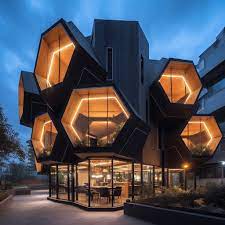The Timeless Beauty of Architecture
Architecture is more than just buildings; it is a reflection of society, culture, and history. From ancient wonders like the Pyramids of Giza to modern marvels such as the Burj Khalifa, architecture has always been a powerful form of expression.
Architects blend art and science to create structures that not only serve a functional purpose but also evoke emotions and inspire awe. The intricate details of Gothic cathedrals, the sleek lines of modern skyscrapers, and the sustainable designs of eco-friendly buildings all showcase the diversity and creativity within the field.
Architectural styles vary across different regions and time periods, each telling a unique story about the people who built them. From the classical columns of ancient Greece to the ornate palaces of India, architecture reflects the values and beliefs of civilizations throughout history.
Today, architects continue to push boundaries with innovative designs that challenge traditional norms and embrace new technologies. Sustainable architecture, adaptive reuse projects, and smart buildings are just some examples of how architects are shaping the future while preserving the past.
Whether it’s a grand cathedral or a humble dwelling, architecture has the power to transform spaces and create memorable experiences for those who interact with it. The beauty of architecture lies in its ability to transcend time and connect us to our past while inspiring us to imagine a better future.
Exploring Architecture: Understanding Its Significance, Styles, Sustainability, Landmarks, Technological Impact, and Career Pathways
- What is architecture and why is it important?
- What are the different architectural styles throughout history?
- How do architects approach sustainable design?
- What are some famous architectural landmarks around the world?
- How does technology influence modern architecture?
- What qualifications are needed to become an architect?
What is architecture and why is it important?
Architecture is the art and science of designing and constructing buildings and other physical structures. It goes beyond mere aesthetics, encompassing functionality, sustainability, and cultural significance. Architecture plays a crucial role in shaping the way we live, work, and interact with our surroundings. It provides shelter, defines spaces, and influences our daily experiences. From iconic landmarks that symbolize a city’s identity to humble homes that provide comfort and security, architecture impacts every aspect of our lives. By blending creativity with practicality, architecture not only serves a utilitarian purpose but also enriches our lives by creating environments that inspire, evoke emotions, and reflect the values of society.
What are the different architectural styles throughout history?
Throughout history, architecture has evolved and diversified, giving rise to a rich tapestry of different styles that reflect the cultural, social, and technological contexts of their time. From the grandeur of ancient Egyptian, Greek, and Roman architecture to the intricate details of Gothic cathedrals and the elegant simplicity of Renaissance palaces, each era has left its mark on the built environment. The industrial revolution brought about new materials and construction techniques, leading to the rise of modernist movements like Art Deco and Bauhaus. Today, contemporary architects draw inspiration from a wide range of influences, blending traditional elements with cutting-edge design concepts to create innovative structures that redefine our urban landscapes.
How do architects approach sustainable design?
Architects approach sustainable design by integrating environmentally conscious principles into every stage of the design process. They consider factors such as energy efficiency, use of sustainable materials, water conservation, and site orientation to minimise the environmental impact of a building. Architects also focus on creating spaces that promote occupant health and well-being through natural lighting, ventilation, and green spaces. By prioritising sustainability, architects not only reduce the carbon footprint of buildings but also contribute to a more resilient and eco-friendly built environment for future generations.
What are some famous architectural landmarks around the world?
Famous architectural landmarks around the world are a testament to human creativity and ingenuity. From the iconic Eiffel Tower in Paris to the majestic Taj Mahal in India, these structures captivate visitors with their beauty and historical significance. The Great Wall of China, the Sydney Opera House, and the Colosseum in Rome are just a few examples of architectural marvels that have stood the test of time and continue to inspire awe and admiration. Each landmark tells a unique story about its culture, heritage, and the craftsmanship of those who designed and built them, making them must-visit destinations for travellers seeking to experience the wonders of architecture on a global scale.
How does technology influence modern architecture?
Technology plays a pivotal role in shaping modern architecture, revolutionising the way buildings are designed, constructed, and experienced. From advanced software for 3D modelling and simulation to innovative building materials and construction techniques, technology has enabled architects to push the boundaries of creativity and functionality. The integration of sustainable technologies such as solar panels, smart building systems, and energy-efficient designs has not only reduced the environmental impact of buildings but also enhanced the overall quality of living spaces. Virtual reality and augmented reality tools have transformed the way architects present their designs and allow clients to experience spaces before they are built. In essence, technology serves as a catalyst for innovation in modern architecture, enabling architects to realise their visions in ways that were previously unimaginable.
What qualifications are needed to become an architect?
To become an architect, individuals typically need to complete a recognised architecture degree programme accredited by the relevant professional bodies, such as the Royal Institute of British Architects (RIBA) in the UK. These programmes often require a strong foundation in subjects like mathematics, design, and technology. After obtaining a degree, aspiring architects usually undertake practical training through internships or placements to gain hands-on experience in the field. Subsequently, they must pass the necessary professional examinations and register with the architectural regulatory body in their country to practice legally as a qualified architect. Continuous professional development is also essential for architects to stay updated with industry standards and trends throughout their careers.

